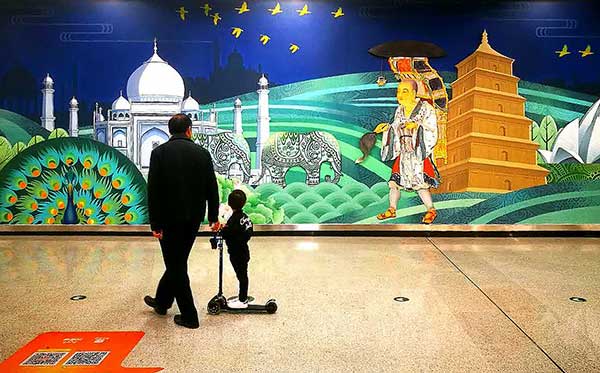
The operator of Xi'an's subway system has defended a controversial mural of an ancient monk that commuters have criticized as historically inaccurate.(Huo Yan/China Daily)
The operator of Xi'an's subway system has defended a controversial mural of an ancient monk that commuters have criticized as historically inaccurate.
The wall painting, which depicts Xuanzang, a monk from the Tang Dynasty (618-907), visiting the Taj Mahal, is only a work of art that highlights the cultural links between China and India, according to Xi'an Metro Co.
Lotus Temple in Delhi, completed in 1986, also appears, the company said in a statement, adding, "The use of two symbolic elements of different times showcase the change and development of Indian culture."
A senior employee with the subway operator, who did not want to be identified, said on Thursday that there was no plan to change or remove the mural, which is at Dayanta Metro Station on Line 3. No mistake was made, he added.
The painting sparked debate on social media, as netizens said that the construction of the Taj Mahal is not from the time when Xuanzang, a key figure in Chinese Buddhism who set off on an arduous trip to India, studied there for 17 years, then brought back many Buddhist sutras and translated them into Chinese during the early Tang Dynasty.
The Taj Mahal, built in Agra between 1631 and 1648 during the Mughal Empire, is reckoned by the UNESCO World Heritage Centre to be the "jewel of Muslim art in India and one of the universally admired masterpieces of the world's heritage".
"The Mughal Empire at that time was an Islamic state. So did Xuanzang go to India to study the Quran?" Xi Wuyi, a professor of Marxism studies at the Chinese Academy of Social Sciences, wrote on Sina Weibo. The post was reposted close to 2,000 times.
Mei Xinyu, a newspaper columnist, also directed a jab at the Xi'an Metro for the seeming historic inaccuracy, saying that it could stain the city's image.
Yu Yingquan, a Xi'an resident who lives near the Dayanta Metro Station, said she does not believe that art has to be 100 percent accurate. "In the process of artistic creation, each element can be flexible," she said.
Wall paintings in other subway stations in Xi'an, the capital of Shaanxi province, also received criticism as some residents said they have wrongly mapped out the geographic locations of some cities in the world, local media reported.


















































